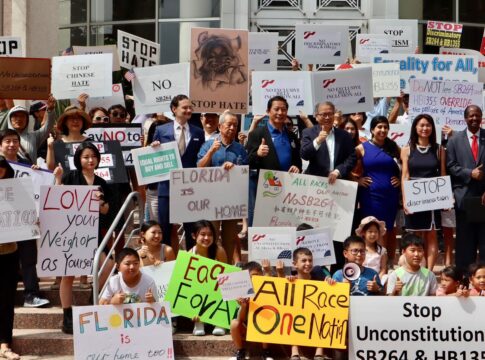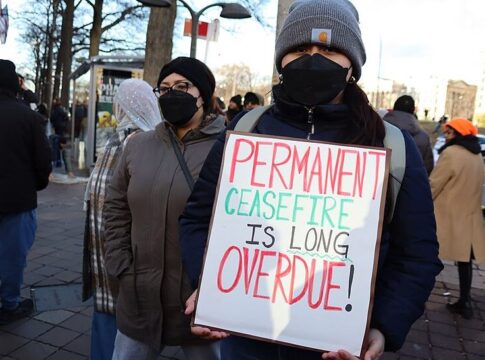by Julia Tong, AsAmNews Contributor
How does the average American view the AAPI community? The “Social Tracking of Asian Americans in the U.S.” (STAATUS) Index survey attempts to answer that question.
For years, organizations like AAPI Data have been conducting important studies analyzing how Asian American and Pacific Islanders viewed social issues. But that work didn’t capture the perceptions most Americans held about AAPIs— including harmful stereotypes that could lead to violence. The initial release of the STAATUS Index survey in 2021 marked the first nationwide study on attitudes toward AAPIs for two decades.
Norman Chen is CEO of The Asian American Foundation (TAAF), which conducts the annual STAATUS Index. He says that the study is critical to filling those gaps.
“Our AAPI community has doubled in that 20 year period,” he said. “We’ve been invisible. We’ve been ignored, frankly. And so that’s why [the STAATUS Index] was really eye opening.”
LATEST STORIES
Since then, the STAATUS Index has been a critical tool to understanding how Asian Americans are viewed in the US. On May 2nd, TAAF released the study’s most recent edition, which examines a nationally representative sample of 5,235 US-based respondents over the age of 16. The resulting 54-page report is a comprehensive and wide-ranging examination of how non-AAPIs view Asian Americans— as well as concerns expressed by the Asian American community itself.
The most “alarming” conclusion from the report, per Chen, is the revelation that 1 in 2 Asian Americans feel unsafe in the United States, continuing trends found in the previous two versions of the Index.
“The safety and belonging issues are paramount for our community. It’s been continuing, obviously, at a high pace since COVID,” he said.
“And it continues today, in terms of breeding trauma and pain for our community.”
The 2023 STAATUS Index Report identifies the reasons behind the lack of safety and belonging many Asian Americans felt. The study’s authors reference ongoing tropes that have historically affected Asian Americans, such as the model minority myth, perpetual foreigner trope, and yellow peril. However, they also underline the central role that modern events have played in breeding anti-Asian sentiment in the US.
Central to this is intensifying tensions between the US and China. For instance, 82% of STAATUS Index respondents reported viewing China as military or national security threat; 74% as an economic threat. Yet, as the study notes, Americans hold “contradictory” attitudes towards AAPIs. Though 79% of respondents do not believe people of Chinese descent pose threat to national security, a third still believed that Chinese and other Asian Americans are more loyal to their perceived country of origin than the US.
Chen argues that these Sinophobic tendencies reinforce the “perpetual foreigner” myth that implies Asian Americans are not fully part of American society. Furthermore, conflating Asian Americans with the Chinese government will only spark more violence against AAPIs— as it already had done during the COVID-19 pandemic.
“At this stage right now, people say they can distinguish between Chinese Americans or people of Chinese descent and China, or the Chinese Communist Party,” he says. “We worry that over time, just like with COVID, people will blur the lines and basically scapegoat Chinese Americans and Asian Americans for rising tensions with China.”
Another—and perhaps more significant— factor identified in the Index is the lack of “belonging” that many Asian Americans respondents reported. 78% of AAPIs did not feel that they truly belonged and were accepted in the US— the highest levels of all racial groups, compared to 75% of Hispanic, 76% of Black, and 43% of White respondents— continuing trends found in previous years of the study.
This year, researchers found that the major factor driving the lack of belonging Asian American respondents felt is the personal experiences of racism that respondents lived through. 58% of Asian American respondents reported experiencing discrimination directly related to their race. Furthermore, around a third of Asian Americans reported feeling unsafe on public transit; 19% in their own neighborhood or schools.
“It really came out that people had directly experienced discrimination,” says Chen. “So if you are in school, you’re at work and you’re discriminated against because of your race or skin color— that really makes you feel like, ‘hey, I don’t belong here. I’m not accepted.’”
A secondary factor is a lack of representation and visibility in American society. 43% of Asian American respondents report feeling that they don’t belong due to the lack of AAPI representation in positions of power. For instance, no Supreme Court justices identify as Asian American. Only 5-6% of workplace senior leadership is Asian American, despite AAPIs making up 13-16% of the workforce.
This gap may be exacerbated by broader societal biases against Asian Americans in positions of power. For instance, 84% of non-AAPI respondents agreed being comfortable with an Asian American friend, but only 66% with an Asian American President or Vice President of the US.
In addition, the 2023 STAATUS Index highlights an alarming lack of awareness about Asian Americans. Aside from misrepresentation in media (69% of Asian American, and 64% of all respondents, agree that AAPIs are somewhat or highly inaccurately portrayed in film/TV), the study shows how Asian Americans continue to remain invisible in American media, history textbook, and the broader public consciousness.
For instance, when asked to name a famous Asian American, 26% of respondents were unable to do so. Of those who could, the top figures mentioned were Jackie Chan, who was originally from Hong Kong, and Bruce Lee, who passed away 50 years ago. (Kamala Harris came in 3rd in 2023.)
This lack of awareness extended to historical events as well. 3 out of 10 respondents could not name a single historical policy or event involving AAPIs. The top two events identified were WWII-era Japanese incarceration and the bombing of Pearl Harbor— an event which does not reflect Asian American history. Meanwhile, other pivotal events were markedly underknown: Only 34% of respondents knew about the murder of Vincent Chin, 46% of Fred Korematsu, 49% of the Hawaiian Kingdom being overthrown, and 57% of the Chinese Exclusion Act.
These results, Chen points out, reflect how AAPI history is often not taught in American school, especially in K-12 education.
“Asian American Pacific Islander history is a part of American history,” he says. “And if people don’t recognize that or don’t understand that, they will increasingly see Asian Americans and Pacific Islanders as foreigners.”
The study’s conclusions, however, may not affect or represent the diverse population of Asian Americans in the US. Small sample sizes made disaggregating data on the AAPI community difficult, preventing more detailed analyses of various AANHPI subgroups. For instance, South Asians, who drive the growth of the Asian American population today, are less affected by yellow fever and Sinophobia than East Asians.
Chen points out that these disparities are also partially a result of the study’s mandate to measure broader US perceptions of Asian Americans. The vast majority of non-AAPI respondents associate Asian Americans with people of East Asian descent— an effect which is magnified due to current geopolitical tensions with China. However, this hasn’t always been the case: For instance, South Asians were primarily targeted after 9/11.
These observations, Chen says, makes clear the importance of solidarity within the AAPI community to fight anti-Asian hate against all.
“Unfortunately, hate manifests itself in many different forms,” he says. “And so we as a community to work together, certainly within the AAPI community to support each other.”
Ultimately, though, Chen says the 2023 Index also left him feeling “hopeful.” After all, most survey respondents report being open to meeting, and learning more about, AAPIs. Approximately 3 out of 5 respondents agree that incorporating Asian American experience into teaching American history is important. Meanwhile, 1 in 4 think they share a lot of economic interests and core values with AAPIs— creating an opportunity to grow understanding with Asian Americans nationwide.
Though these highlight future possibilities in addressing anti-Asian hate, Chen emphasizes that there is still much work to be done.
“[Anti-Asian] stereotypes are deeply embedded in American society. It’s going to take time to change them,” he says. “It’s going to take a concerted effort by organizations like TAAF and other community leaders to really change that education, change the narrative, change in our country.
“We’re making great progress. Hopefully, with more organization, more resources, we can do even more.”
AsAmNews is incorporated in the state of California as Asian American Media, Inc, a non-profit with 501c3 status. We are currently funded by our readers and the California Library Commission’s Stop The Hate program under the State Dept of Social Services. See their funded resources for direct, prevention and intervention services here. Find additional content from AsAmNews on Instagram , Twitter, Tiktok and Facebook. Please consider interning, joining our staff, or submitting a story, or making a tax-deductible donation.









